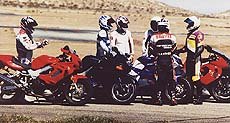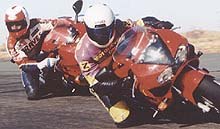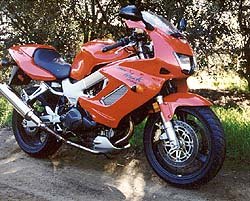Motorsports Racing News & Blog Articles
Church of MO: Sport Twins 1997
If it’s 2022 then 25 years ago must’ve been 1997, when Motorcycle Online was still trying to gain traction in the moto mediaverse. Probably not helped along by Editor Plummer writing that new riders should skip the Suzuki TL1000 and just go straight to the morgue. There were videos of the Sport Twins in action, though, which seem to have been lost in the sands of time, but must’ve been a treat to watch over your dial-up modem. The Suzuki did well in this little comparison in spite of the abuse, but I can’t remember the last time I’ve seen one. The SuperHawk on the other hand, has become a bit of a cult favorite, and still warms the old cockles occasionally.
Where’s the Duck?
 |
 |
 |
 |
 |
Super HawkV-Twin fans have been begging Honda for a larger version of the discontinued 650 Hawk GT since that model’s introduction in 1988. With the VTR1000F, Honda has finally given them what they wanted. While the Hawk used a traditional beam-style frame, the VTR is equipped with a combination of aluminum beam and trellis frame to support its new mill. Honda engineers have stated that rear wheel input to the chassis can cause front wheel instability in a typical beam frame design — an “echo effect.” Thus, Honda claims the VTR’s frame has been designed to cancel this problem. Does it work? We guess so — the Honda is much more stable that Suzuki’s TL1000.Honda shines in other areas, too, notably the styling department. Its attractive fairing — which resembles the upper unit from a CBR-F3 — is far better looking than the Suzuki’s Ducati imitation. Similarly, the VTR’s nicely sloped tail section is miles ahead in terms of styling than the pimple-shaped unit on the TL.
Different design philosophies between the two manufacturers are apparent the first time you swing a leg over these bikes. Suzuki’s TL folds its pilot into an aggressive riding position with high pegs and clip-ons mounted under the triple clamps. Honda’s VTR, while still sporty, features a more upright riding position, is a little more roomy and places less weight on the rider’s wrists. Sitting on the Honda for the first time is quite surprising: With its twin side-mounted radiators and slim frame, the VTR feels more like a bike half its size.With ten fewer ponies than the TL, a longer wheelbase, lower seat height, and a more rearward weight bias, the VTR isn’t as wheelie prone as its Suzuki rival. This isn’t to say the Honda isn’t capable of such antics, however, because an extra twist of throttle and snapping of the clutch will send its front wheel skyward with ease. But the Honda’s smooth, linear powerband makes it feel far less potent than the bucking TL, and it is: At Los Angeles County Raceway our VTR clicked off an impressive 10.83 second quarter-mile at 127.32 mph, compared with 10.53 at 133.06 mph for the TL. This may not sound like much, but 3/10ths of a second in the quarter mile means one bike “walks away” from the other.
Throw in some curves though, and the margin closes. During our racetrack testing at The Streets of Willow, the VTR trailed by less than a second. Although the Honda’s 41mm fork is 2mm narrower and lacks the compression adjustability of the TL’s inverted unit, it tracks through both slow and fast corners with a remarkable sense of stability. Out back, its rear damper is also devoid of compression damping, yet manages to do a decent job of soaking up pavement irregularities, as long as speeds aren’t too high. When the going gets fast, the VTR’s soft, street-based suspension, chassis flex and limited ground clearance becomes a concern. Honda makes no bones about this, though. They’ve clearly stated the VTR’s mission in life is not to be a racing platform. They would rather trade off that extra edge of track performance for real world comfort. We think they’ve succeeded.
What we have here is a bike that can almost hold its own at the racetrack and dragstrip, is great fun around town, commuting or on the freeway and a blast to ride in the canyons. But in this test it finishes second. What gives? Suzuki’s TL1000, that’s what.
1. Suzuki TL1000S

A view to a kill: Send Shawn Higbee out for some “exciting video footage” and he gives us an on-board highside flic. Maybe we should’ve been more specific…While Honda already has a history of V-Twin sportbikes, Suzuki is working with a fresh mold. Although judging by the looks of their frame, headlights and fairing, they did have some Ducati blueprints to work with. Too bad they didn’t copy the 916’s seductive tail section though.

Once the fashion show is over — and we’re all done gagging — we’re ready to ride. Thumb the Suzuki’s start button and immediately you’re rewarded with a pleasing mechanical medley from its chain/gear driven cams that invites mindless throttle blipping at intersections. Click the six-speed gearbox into first, give it some gas, let out the clutch and, if you’re like us, the bike stalls. Below 2,500 rpm, Suzuki’s fuel-injection isn’t mapped out as well as we would like — a problem compounded by an ultra-light flywheel — causing some awkward moments.Once you’ve successfully pulled away and have found a wide open stretch of pavement you’re in for a treat. Wringing a TL to redline is an experience not to be missed, and not for the faint of heart. With 114 horses on tap and an arm-stretching 72.6 ft-lbs of torque, the TL rockets forward with the velocity of an open-class sportbike. Plus its lofty seat height and short (55.7 inch) wheelbase combine to make the TL a wheelie monster. Accelerating hard through first and second gears will loft the TL’s front wheel every time, making for constant grins on twisty roads where the TL pilot can square off a corner and wheelie to the next.
Copyright
© Motorcycle.com

